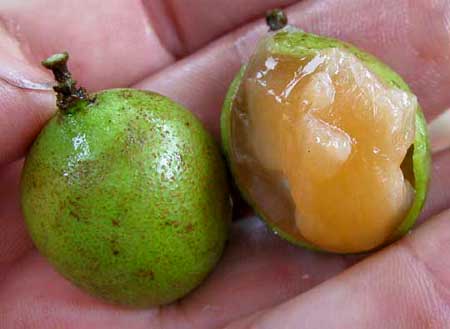
There's Guava, and there's Guaya -- unrelated and unlike one another, just with similar names. Most Northerners first discover Guaya fruits piled on stands along streets or as they slow their cars at topes on the highway where folks are standing holding up guaya fruits -- maybe calling them by the Spanish name mamoncillos, or the Maya name uayum. Those are guaya fruits below:

You buy a bunch, pull off a fruit, bite the green shell not too hard, and the thin husk readily cracks apart freeing a succulent, pinkish-cream pulp, as shown on the next page. Once the Guaya fruit's shell is cracked, the pulp easily plops into the mouth. It tastes like slightly sour grape flesh, and you're a little disappointed that the flesh so thinly covers a very big seed. As you suck on the seed the flesh expands.
The seed, I read, can be roasted like a chestnut. Some folks chill Guaya fruits in their freezers, then during hot times serve them as cold, tangy snacks. The local Maya eat them with chili powder, salt, and lime.

The Guaya tree is Melicoccus bijugatus, a member of the same family that includes Litchi fruits and the North's weedy balloon-vines, the mostly tropical Soapberry Family, or Sapindaceae. Guaya trees are fairly large and bear pinnately compound leaves typically with four leaflets.
There's some confusion about what tree is actually the Guaya. The Guaya producing the fruits shown above, Melicoccus bijugatus, is native to northern South America but is widely planted and often naturalized through all of hot tropical America, and beyond. It's not a wild tree in the Yucatan's forests.
However, if you ask a Maya farmer to show you a Guaya, he may well lead you to a large, wild tree in the forest -- one also with pinnately compound leaves bearing four leaflets -- and say that it's a Guaya, or Uayum. In fact that's the very similar, closely related, native tree Talisia oliviformis. If you ask the Maya directly about different kinds of Guaya or Uayum, usually it'll be admitted that indeed there are two kinds of Guaya, one producing the big fruits illustrated above, and the other, this forest-dwelling one, with a smaller fruit, also edible, but not eaten as frequently, and that's Talisia oliviformis.
The leaves of wild Guayas are wider, thinner and hairless, while those of the planted Guayas are more narrow, leathery and hairy. The planted Guayas have been cultivated for so long that several cultivars have been produced, including some with extra sweet fruits.